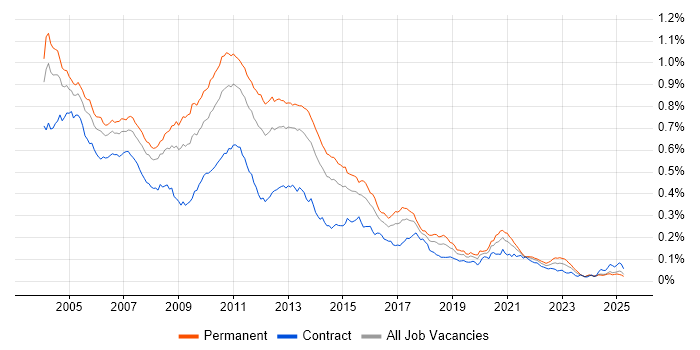N-Tier
UK
The table below looks at the prevalence of the term N-Tier in permanent job vacancies. Included is a benchmarking guide to the salaries offered in vacancies that cited N-Tier over the 6 months leading up to 15 May 2025, comparing them to the same period in the previous two years.
| 6 months to 15 May 2025 |
Same period 2024 | Same period 2023 | |
|---|---|---|---|
| Rank | 692 | 867 | 846 |
| Rank change year-on-year | +175 | -21 | +235 |
| Permanent jobs citing N-Tier | 13 | 30 | 131 |
| As % of all permanent jobs advertised in the UK | 0.024% | 0.030% | 0.13% |
| As % of the Miscellaneous category | 0.065% | 0.085% | 0.30% |
| Number of salaries quoted | 9 | 21 | 79 |
| 10th Percentile | £43,600 | - | £52,250 |
| 25th Percentile | £63,750 | £52,500 | £53,750 |
| Median annual salary (50th Percentile) | £68,525 | £60,000 | £70,000 |
| Median % change year-on-year | +14.21% | -14.29% | - |
| 75th Percentile | - | £62,500 | £73,750 |
| 90th Percentile | £81,000 | £95,050 | £91,500 |
| UK excluding London median annual salary | £68,525 | £57,500 | £70,000 |
| % change year-on-year | +19.17% | -17.86% | -5.08% |
All Generic Skills
UK
N-Tier falls under the General and Transferable Skills category. For comparison with the information above, the following table provides summary statistics for all permanent job vacancies requiring generic IT skills.
| Permanent vacancies with a requirement for generic IT skills | 20,117 | 35,114 | 43,636 |
| As % of all permanent jobs advertised in the UK | 36.47% | 35.46% | 43.49% |
| Number of salaries quoted | 9,817 | 23,006 | 23,361 |
| 10th Percentile | £31,250 | £28,000 | £35,375 |
| 25th Percentile | £42,500 | £38,000 | £46,250 |
| Median annual salary (50th Percentile) | £60,000 | £55,000 | £65,000 |
| Median % change year-on-year | +9.09% | -15.38% | +4.00% |
| 75th Percentile | £78,750 | £75,000 | £86,250 |
| 90th Percentile | £110,000 | £97,500 | £108,750 |
| UK excluding London median annual salary | £55,000 | £50,000 | £55,000 |
| % change year-on-year | +10.00% | -9.09% | +4.76% |
N-Tier
Job Vacancy Trend
Job postings citing N-Tier as a proportion of all IT jobs advertised.

N-Tier
Salary Trend
3-month moving average salary quoted in jobs citing N-Tier.
N-Tier
Salary Histogram
Salary distribution for jobs citing N-Tier over the 6 months to 15 May 2025.
N-Tier
Top 10 Job Locations
The table below looks at the demand and provides a guide to the median salaries quoted in IT jobs citing N-Tier within the UK over the 6 months to 15 May 2025. The 'Rank Change' column provides an indication of the change in demand within each location based on the same 6 month period last year.
| Location | Rank Change on Same Period Last Year |
Matching Permanent IT Job Ads |
Median Salary Past 6 Months |
Median Salary % Change on Same Period Last Year |
Live Jobs |
|---|---|---|---|---|---|
| England | +131 | 13 | £68,525 | +14.21% | 30 |
| UK excluding London | +169 | 10 | £68,525 | +19.17% | 21 |
| South West | +124 | 7 | £68,525 | +90.35% | 1 |
| Work from Home | +132 | 3 | £40,250 | -38.08% | 16 |
| London | +96 | 3 | £83,750 | -1.59% | 15 |
| South East | +85 | 1 | - | - | 7 |
| North of England | +51 | 1 | £64,500 | +7.50% | 7 |
| North West | -4 | 1 | £64,500 | +7.50% | 3 |
| Midlands | - | 1 | £47,500 | - | 1 |
| West Midlands | - | 1 | £47,500 | - |
N-Tier
Co-occurring Skills and Capabilities by Category
The follow tables expand on the table above by listing co-occurrences grouped by category. The same employment type, locality and period is covered with up to 20 co-occurrences shown in each of the following categories:
